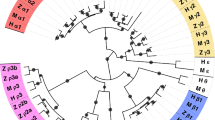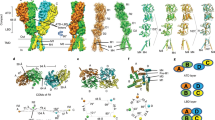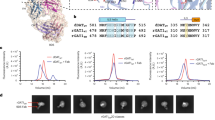Abstract
A PROTEIN having a high affinity for d-tubocurarine has been isolated from ammonium sulphate fractions of extracts of electric organ of electric eel1,2. Although d-tubocurarine combines with a variety of macromolecules3–5, the reaction with the electric organ protein appeared to be somewhat unique, especially since the resulting complex is very stable to high ionic strength1. The protein also combines in a more or less specific way with a large number of neurotropic compounds, the relative affinities in general paralleling the effectiveness of these compounds in their pharmacological action upon the single isolated electroplax1,2,5,6 and squid giant axon7,8. Although it was proposed1,2 that the protein might function in vivo as a ‘receptor’ for acetylcholine and other neurotropic compounds, more recent evidence has led to a suggestion of an entirely different role9,10, namely, that the protein might be the drug-binding component of conducting membranes only and thus is not involved in the physiological effects of acetylcholine and other depolarizing agents. The distribution of this material in the electroplax is thus of primary importance in determining whether or not the conclusions regarding its proposed biological significance are justified.
This is a preview of subscription content, access via your institution
Access options
Subscribe to this journal
Receive 51 print issues and online access
$199.00 per year
only $3.90 per issue
Buy this article
- Purchase on Springer Link
- Instant access to full article PDF
Prices may be subject to local taxes which are calculated during checkout
Similar content being viewed by others
References
Ehrenpreis, S., Biochim. Biophys. Acta, 44, 561 (1960).
Ehrenpreis, S., in Bioelectrogenesis, edit. by Chagas, C., and de Carvalho, A. P., 397 (Elsevier, Amsterdam, 1961).
Ehrenpreis, S., Biochim. Biophys. Acta, 44, 577 (1960).
Ehrenpreis, S., Symp. Molecular Association Complexes of Polymers, Abst. 138th Meeting Amer. Chem. Soc., New York, Sept. 1960, 15T.
Ehrenpreis, S., and Kellock, M. G., Biochem. Biophys. Res. Comm., 2, 311 (1960).
Ehrenpreis, S., and Bartels, E. (unpublished results).
Rosenberg, P., and Ehrenpreis, S., Nature, 190, 728 (1961).
Rosenberg, P., and Ehrenpreis, S., Biochem. Pharmacol., 8, 192 (1961).
Ehrenpreis, S., J. Assoc. Res. Nervous and Mental Dis. (in the press).
Ehrenpreis, S., Symp. Modern Concepts in the Relationship between Chemical Structure and Biological Activity; First Intern. Pharmacol. Meeting, Stockholm, Sweden Biochem. Pharmacol (in the press); Fed. Proc., 21, 334 (1962).
Ehrenpreis, S. (unpublished results).
Coons, A. H., and Kaplan, M. H., J. Exp. Med., 91, 1 (1950).
Cohen, S. (unpublished results).
Webb, G. D., and Walsh, R. R., Fed. Proc., 20, 346 (1961).
Author information
Authors and Affiliations
Rights and permissions
About this article
Cite this article
EHRENPREIS, S. Immunohistochemical Localization of Drugbinding Protein in Tissues of the Electric Eel. Nature 194, 586–587 (1962). https://doi.org/10.1038/194586a0
Issue Date:
DOI: https://doi.org/10.1038/194586a0
This article is cited by
-
Curare and Acetylcholine Receptor Substance
Nature (1968)
-
Acetylcholine and Nerve Activity
Nature (1964)
Comments
By submitting a comment you agree to abide by our Terms and Community Guidelines. If you find something abusive or that does not comply with our terms or guidelines please flag it as inappropriate.



